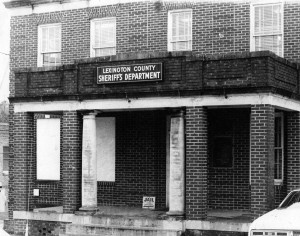Today’s Lexington County Sheriff’s Department is part of a proud 200-year tradition of service and commitment to the community.
The first recorded Sheriff of Lexington County was Thomas Herbert who was appointed to the office in 1806. The first courthouse and jail for the area was located in the town of Granby (located in present day Cayce). Back then, the Sheriff’s Department was a one-man operation with the sheriff living and working in the jail and courthouse.
The early days of the Sheriff’s Department were greatly influenced by the Civil War. In fact, the county’s third courthouse and jail, which was located in the present day Town of Lexington and built in 1838, was set afire and destroyed in February 1865 by Union Army troops under the command of General William T. Sherman. Many Lexington County Sheriffs were veterans of the Civil War to include George Swygert, Samuel Roof, Henry Geiger, Samuel Drafts, and George Drafts. Another sheriff, John Fox, had an extensive political career after leaving office. John Fox served as sheriff from 1828 to 1832 and 1836 to 1840, and after leaving office served as the County’s Clerk-of-Court, as a member of the South Carolina House of Representatives, and as a South Carolina State Senator.
Most jails and courthouses were constructed and located on Main Street in Lexington including the old courthouse and jail located at 139 East Main Street which was built in 1940. This facility housed a maximum of 42 inmates. By the 1960s, the facility was too small to accommodate the Sheriff’s Department’s needs. A new law enforcement facility was constructed in the late 1970’s. This law enforcement facility, located at 521 Gibson Road, still serves as the main headquarters facility for the Lexington County Sheriff’s Department. A new jail was built in 1999, and the Sheriff’s Department complex has undergone many renovations since 1972.
In addition to changing facilities and personnel, the very nature of law enforcement in Lexington County has also significantly changed in the past thirty years. Until the 1970s, most investigative activities focused on illegal whiskey brewers and a few major crimes such as homicide and rape. In the late 1960s and early 70’s, drug use and distribution became a significant problem. Along with drugs, other crimes grew in frequency including business robberies, computer crimes, domestic violence, and fraud. Today, increased calls-for-service and population in Lexington County have further stretched law enforcement resources and challenged the Lexington County Sheriff’s Department to keep pace with changing law enforcement needs.
Examining the past provides insight into the tremendous growth of Lexington County and emphasizes the important measures being taken by the Sheriff’s Department and Lexington County officials to plan for the future.
Lexington County Sheriffs
| 1806 | Thomas S. Herbert |
| 1806-1808 | James McGowan |
| 1808-1813 | Authur Friday |
| 1813-1814 | M. Ogilvie |
| 1814-1815 | William Snelgrove |
| 1815-1816 | James Pou |
| 1816-1817 | Henry Seibles |
| 1817-1821 | Amos Banks |
| 1821-1825 | George Haltiwanger |
| 1825-1828 | Amos Banks |
| 1828-1832 | John Fox |
| 1833-1836 | Reuben Harmon |
| 1836-1840 | John Fox |
| 1840-1843 | William L. Miller |
| 1844-1848 | Isaac Vansant |
| 1848-1852 | John H. Kleckley |
| 1852-1856 | Isaac Vansant |
| 1856-1860 | Simon P. Wingard |
| 1860-1864 | Nathaniel Harmon |
| 1864-1866 | George S. Swygert |
| 1866-1871 | Samuel M. Roof |
| 1871-1876 | Henry H. Geiger |
| 1876 | Charles J. Hendrix |
| 1877-1882 | Samuel P. Drafts |
| 1882-1883 | Walter M. Drafts |
| 1883-1896 | George S. Drafts |
| 1896-1904 | Thomas H. Caughman |
| 1904-1912 | Patrick H. Corley |
| 1912-1920 | Simeon J. Miller |
| 1920-1924 | Emanuel A. Roof |
| 1924-1940 | Holland C. Oswald, Sr. |
| 1940-1948 | Henry M. Caughman |
| 1948-1952 | Holland C. Oswald, Sr. |
| 1952-1956 | Henry M. Caughman |
| 1956-1968 | Fred H. Boatwright |
| 1968-1972 | Carroll Day |
| 1972-2014 | James R. Metts |
| 2014-2015 | A. Lewis McCarty |
| 2015-Present | Bryan “Jay” Koon |

